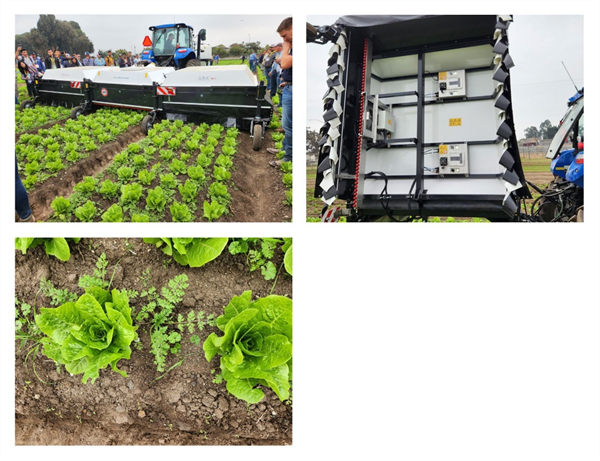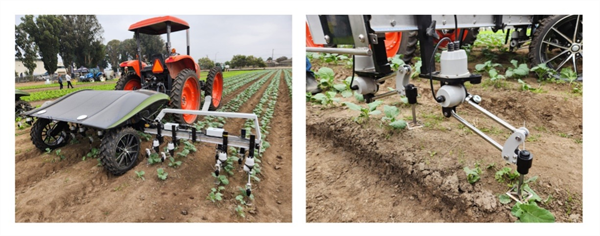
It’s unfortunately a very great season to be a plant pathologist…
We have confirmed the first sample of Fusarium wilt on lettuce submitted to the Yuma Plant Health Clinic from Yuma County. The stunted seedlings looked like any other typical case of damping-off at the seedling stage. When plated on culture media, subsequently confirmed Fusarium colonies grew abundantly from the declining plant tissues. If you’re not already on guard and scouting, this is a warning that Fusarium is active in Yuma County.
Adding on to this early alert, we’ve received a surge of submissions of young brassicas to the clinic. Several severely wilted and declining plants from around Yuma County have cultured positive for Pythium, likely as an opportunistic invader coming in on the back of all the early-season rain that brought stress to seeds and young transplants. Growers may want to consider oomycides, but only if the seedling disease is first confirmed to be Pythium. Remember, many seedling diseases caused by true fungi are indistinguishable from those caused by Pythium.
If you have any concerns regarding the health of your plants/crops please consider submitting samples to the Yuma Plant Health Clinic for diagnostic service or booking a field visit with me:
Chris Detranaltes
Cooperative Extension – Yuma County
Email: cdetranaltes@arizona.edu
Cell: 602-689-7328
6425 W 8th St Yuma, Arizona 85364 – Room 109
At the 2023 FIRA USA Robotics and Autonomous Farming Solutions Forum last month, some of the latest automated and robotic technologies were demonstrated in the field. Several of the weeding technologies demonstrated are brand new to the U.S. and/or Yuma, AZ area. These included a 5.6 inch2 (2.4 x 2.4 inch) resolution fixed boomed spot sprayer (Fig. 1), a high precision, “turret gun” spot sprayer (Fig. 2) and a mechanical weeder that utilizes a unique rotating blade design and lidar for depth control (Fig. 3). Although the test runs were short, I was impressed with the performance and possibilities of these machines. Company representatives said that they would be traveling to Arizona for the season and would like to meet with growers interested in their technology. Company contact information can be found at their respective websites, or feel free to contact me if you would like additional information.

Fig. 1. Ecorobotix1 (Yverdon-les-Bains, Switzerland) precision weeding machine
demonstration at 2023 FIRA USA. The unit has modular, 6.6’ wide spray booms
equipped with 156 individually controllable spray nozzles to spot spray weeds
(top right). A vision system is used to detect weeds and spot spray resolution is
2.4 x 2.4 inches. Darker soil indicates where spray (water) was delivered to
targeted weeds (bottom).

Fig. 3. GreenTech Robotics’ Weed Spider1 (Kelvin Grove, New Zealand)
demonstration at 2023 FIRA USA. The unit is equipped with a vision system for
detecting crop plants and weeds, and blades that move in and out of the crop row
to remove in-row weeds. Lidar sensors are used to create a 3-D image of the soil
surface and control cultivating blade depth.
When I think about Lipid Biosynthesis Inhibitor herbicides, Post (sethoxidim) and Select (clethodim) come to my mind. A great description of these type of herbicides can be found at the Section VI of the Arizona Pest Control Advisor (PCA) Study Guide. They say a good teacher can explain complicated things in a simple way. Please read this explanation by Barry Tickes:
“These herbicides are known as ACCase inhibitors because they inhibit the production of acetyl-coenzyme A carboxylase (ACCase) which is an enzyme needed in the first steps of lipid or fatty acid production. Lipids are needed in the production of new membranes which, among other things, are needed in the production of cell walls. These chemicals move from the foliage to the growing points, only kill grasses, and have very little soil activity. Grasses stop growing immediately and slowly turn chlorotic or red and die usually in 7 to 21 days. These products are used to selectively kill grasses in broadleaf crops".
|
Classification |
Common |
Commercial |
Arizona crop |
|
Aryloxphenoxy |
fluazifop |
Fusilade |
Small grains, |
|
Cyclohexanediones |
sethoxydim |
Poast, Segment, |
Alfalfa, cotton, |
You need to see this .. time lapse photography shows the symptoms of Poast herbicide to wheat.
This time of year, John would often highlight Lepidopteran pests in the field and remind us of the importance of rotating insecticide modes of action. With worm pressure present in local crops, it’s a good time to revisit resistance management practices and ensure we’re protecting the effectiveness of these tools for seasons to come. For detailed guidelines, see Insecticide Resistance Management for Beet Armyworm, Cabbage Looper, and Diamondback Moth in Desert Produce Crops .
VegIPM Update Vol. 16, Num. 20
Oct. 1, 2025
Results of pheromone and sticky trap catches below!!
Corn earworm: CEW moth counts declined across all traps from last collection; average for this time of year.
Beet armyworm: BAW moth increased over the last two weeks; below average for this early produce season.
Cabbage looper: Cabbage looper counts increased in the last two collections; below average for mid-late September.
Diamondback moth: a few DBM moths were caught in the traps; consistent with previous years.
Whitefly: Adult movement decreased in most locations over the last two weeks, about average for this time of year.
Thrips: Thrips adult activity increased over the last two collections, typical for late September.
Aphids: Aphid movement absent so far; anticipate activity to pick up when winds begin blowing from N-NW.
Leafminers: Adult activity increased over the last two weeks, about average for this time of year.







